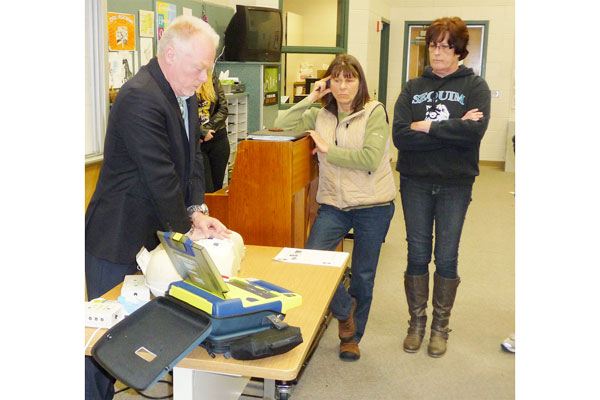Anyone, any time and anywhere. Those are the facts about sudden cardiac arrest. The brain has 4-6 minutes to receive oxygenated blood from the heart before cells start to die. To interrupt that possibility is why the Sequim School District recently has purchased 10 Automated External Defibrillators or AEDs and placed them throughout the district.
“It just seemed like the responsible thing to do,” said Sonja Bittner, the district’s head registered nurse.
During an in-service for all employees on Jan. 27, several dozen learned how to use the life-saving device from certified AED instructor Jeffery Hoyt of Cardiac Sciences in Kirkland.
“If you can open a lid and put on the patches, you can save a life,” Hoyt said.
Hoyt first explained the key differences between sudden cardiac arrest and a heart attack; “Sudden cardiac arrest is not synonymous with a heart attack,” Hoyt said. “In a heart attack, cardiac arteries are clogged to the point that the heart is being deprived of oxygenated blood. It usually has symptoms such as shortness of breath, chest pain and sweating. The onset is slow and most people survive heart attacks.”
Hoyt further explained, “Sudden cardiac arrest is an electrical problem with the heart. There’s no coordination in contractions. The heart is quivering, fibrillating and is an inefficient pump. The person will lose consciousness. You only have a matter of minutes, a window of opportunity of 4-6 minutes before there’s brain damage. If you can shock the person in less than 6 minutes, they usually survive; after 6 minutes they usually die.”
Hoyt said sudden cardiac arrest is the No. 1 cause of death in the U.S. with about 325,000 deaths annually in North America. He added that 13 percent of workplace fatalities are from sudden cardiac arrest and it’s the No. 1 cause of death among young athletes.
“The onset is quick and defibrillation is the only way of changing an electrical malfunction. With CPR alone only about less than 1 percent survive,” Hoyt said. “Because the national average response time for emergency medical services is between 8-12 minutes, victims of sudden cardiac arrest rarely receive defibrillation therapy in time.”
“The AED is used for both witnessed and unwitnessed collapses,” said Bittner, “and the machine decides if treatment is needed. Anybody on campus, students included, can use an AED. In a pinch nobody can be held at fault for trying.”
Bittner said students are trained in their health classes on AEDs and CPR by Clallam County Fire District 3 paramedics.
Hoyt said that in addition to being a responsible action, the reason for the district’s purchase of the AED’s also is “so people are appropriately prepared to resuscitate someone in sudden cardiac arrest. This is the easiest AED to use out there.”
Hoyt then demonstrated how to react to sudden cardiac arrest. First, shake the person and if he or she is unresponsive, have someone dial 9-1-1. Watch for the chest rising and falling. If the person isn’t breathing, grab the AED, open the lid, follow instructions on how to apply the patches — they need to be on dry, bare skin. The AED will determine if defibrillation is needed and if so, it tells the rescuer to stand clear. It also will give directions to push, push, push and then reassess the person’s condition after two minutes for more CPR or another shock. With every minute that passes the survival rate drops by 10 percent.
As for the Sequim School District, there is one defibrillator in each school office, the middle school and high school gyms and in the bus barn. Remember, if you can open an AED’s lid and place the pads properly, you can save a life.



